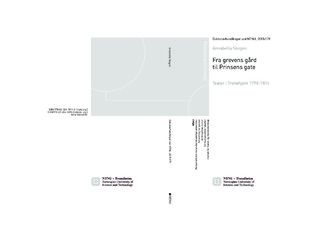| dc.contributor.author | Skagen, Annabella | |
| dc.date.accessioned | 2016-01-25T13:19:44Z | |
| dc.date.available | 2016-01-25T13:19:44Z | |
| dc.date.issued | 2015 | |
| dc.identifier.isbn | 978-82-326-1015-0 | |
| dc.identifier.issn | 1503-8181 | |
| dc.identifier.uri | http://hdl.handle.net/11250/2374749 | |
| dc.description.abstract | Sammendrag av avhandlingen:
Denne avhandlingen tar for seg teaterpraksiser utøvd av innbyggerne i Trondhjem i perioden 1790–1814. Utøverne av teater inngikk i et bredt borgerlig spekter som inkluderte menn og kvinner fra håndverker-, kjøpmanns- og embetsmannsstanden, samt adelens få representanter. Teatret hadde en sentral stilling både innen kultur- og selskapslivet, og befant seg i et skjæringspunkt mellom kunstnerisk uttrykk, sosial aktivitet og dannelsesmarkør. Utøverne er hovedsakelig blitt forstått som amatører, noe som trolig har vært et bidrag til en viss historiografisk nedtoning av periodens teaterhistoriske betydning.
Avhandlingen har som målsetning å bidra med ny innsikt i Trondhjems tidlige teaterhistorie ved å sette periodens teaterpraksis inn i en kulturhistorisk sammenheng. Det teaterhistoriske kildematerialet behandles i lys av kulturelle og politiske strømninger i Danmark-Norge i tiden mellom den franske revolusjon og slutten på det dansk-norske eneveldet i 1814. Perioden åpner et perspektivfelt som inkluderer absolutisme og opplysningsinspirerte, demokratiske og revolusjonære strømninger, dansk-norsk statspatriotisme og norsk nasjonalpatriotisme, spilt ut i relasjonene mellom monark og folk, adel, borgere og bønder, stat og familie. Dette sammensatte feltet kan forstås gjennom ulike identitetsskapende diskurser som teatret var med på å etablere og sirkulere.
Samtidig som avhandlingen gjør rede for de kontekstuelle og empiriske forholdene omkring innbyggernes teaterutøvelse, hviler det viktigste bidraget til ny teaterhistorisk innsikt på en analytisk gjennomgang av periodens teaterhendelser via repertoaret. Skuespilltekstene utgjør et omfangsrikt og teaterhistorisk verdifullt materiale som hyppig tematiserte spørsmål om samfunnsstrukturer og borgerlig identitet, og som hittil ikke har vært tatt i bruk for å generere kunnskap om teaterpraksisens estetiske og sosiale funksjon. På bakgrunn av dette samlede materialet undersøker avhandlingen hvilke identitetsdannende diskurser og praksiser som ble sirkulert og utøvd som del av Trondhjems teatervirksomhet, og hvordan disse kom til uttrykk gjennom organisering, tematiske tendenser og estetiske virkemidler.
Avhandlingen søker å påvise hvordan teaterutøvelsen var en viktig medvirkende faktor i etableringen av en borgerlig offentlighet eller halv-offentlighet som ga rom for en endret borgerlig selvforståelse i overgangsperioden mellom dansk-norsk enevelde og norsk konstitusjonelt monarki. Både gjennom dramatisk egenaktivitet og en formalisert selskapsstruktur kunne borgerne prøve ut og erverve sosiale roller, relasjoner, idealer og identiteter som rommet både systemlojale og reformerende tendenser. I skjæringspunktet mellom en privat selskapelighetskultur og en delvis offentlig teaterkultur bidro teatervirksomheten til å skape et nytt sosialt og fysisk rom i samfunnet. I dette rommet ble kunsten et livsområde og en praksis der borgerne både kunne øve på og utøve sin egen selvfremstillelse og selvforståelse. | nb_NO |
| dc.description.abstract | Summary of the thesis:
This dissertation deals with theatrical practices of the inhabitants of the Danish-Norwegian town of Trondhjem during the period of 1790–1814. The theatre practitioners came from a broad bourgeois (borgerlig/bürgerlich) spectrum including men and women belonging to artisan, merchant and civil servant groups, as well as the few existent representatives of the nobility. The theatre took a central position within cultural as well as society life, and existed in the intersection between artistic expression, social activity and marker of social sophistication. The performers have largely been perceived as amateurs, something which has probably contributed to a certain historiographical downplaying of the period's importance to theatre history.
The dissertation aims to contribute new insights into the early theatre history of Trondhjem by regarding the theatre practices of the period in a context of cultural history. The theatrical source material is viewed in the light of cultural and political tendencies in the twin states of Denmark-Norway during the time between the French revolution and the end of the Danish-Norwegian absolutist state in 1814. The period opens a field of perspectives including absolutism and enlightenment-inspired, democratic and revolutionary trends; Danish-Norwegian state patriotism; and Norwegian national patriotism, played out in the relations between monarch and people, nobility, bourgeoisie and farmers, state and family. This complex field may be understood through various identity-forming discourses which the theatre helped establish and circulate.
While the dissertation explains the contextual and empirical contexts surrounding the inhabitants' theatrical practices, the most important contribution to new theatre historical insight rests on a series of analyses of the period's theatrical events by means of the repertory. The written playtexts constitute a large and valuable material frequently thematising questions related to societal structures and bourgeois identity, which so far has not been put to use to generate knowledge of the theatrical practices' aestethic and social functions. Based on this material, the dissertation examines the identity-forming discourses and practices that were circulated and performed as a part of the theatrical activities in Trondhjem, and how these were expressed through organization, thematic tendencies and aesthetic measures.
The dissertation aims to prove how theatrical practice was a contributing factor in establishing a bourgeois public, or half-public, sphere which enabled a change in bourgeois self-understanding during the transitional period between Danish-Norwegian absolutism and Norwegian constitutional monarchy. Through dramatic activity and a formalised organisational structure, the citizens were able to try out and acquire social roles, relations, ideals and identities containing conservative as well as reformist trends. In the intersection between a private culture of sociability and a partly public theatre culture, the theatrical activity contributed to create a new social and physical space within society. Within this space, art became an arena and a practice where the bourgeoisie were able to practice their own self-projection and self-understanding – as well as put them into practice. | nb_NO |
| dc.language.iso | eng | nb_NO |
| dc.publisher | NTNU | nb_NO |
| dc.relation.ispartofseries | Doctoral thesis at NTNU;2015:179 | |
| dc.title | Fra grevens gård til Prinsens gate: Teater i Trondhjem 1790–1814 | nb_NO |
| dc.type | Doctoral thesis | nb_NO |
| dc.subject.nsi | VDP::Humanities: 000::Movie and drama: 170::Theatre studies: 172 | nb_NO |

